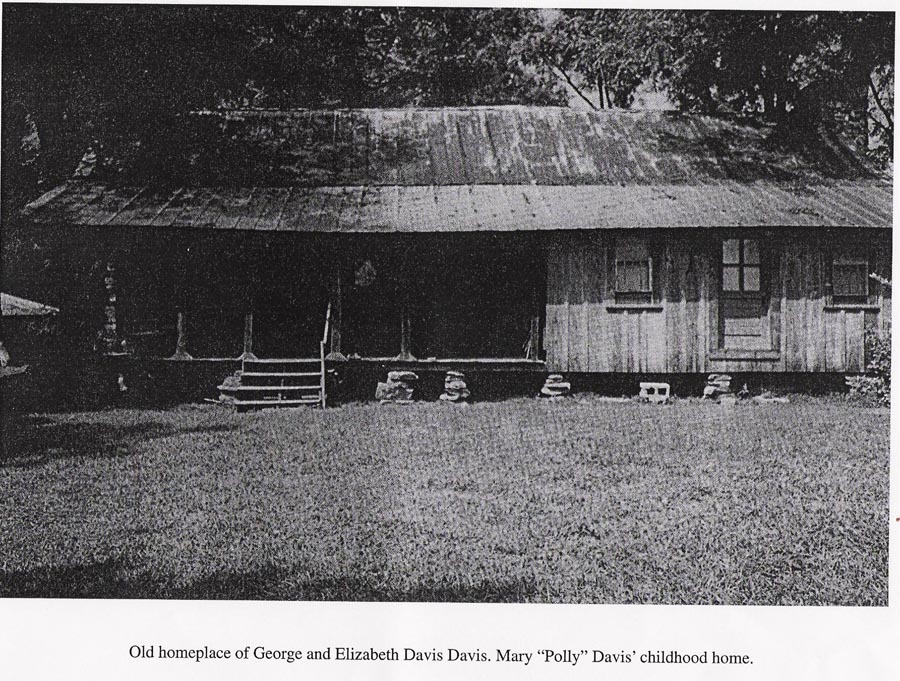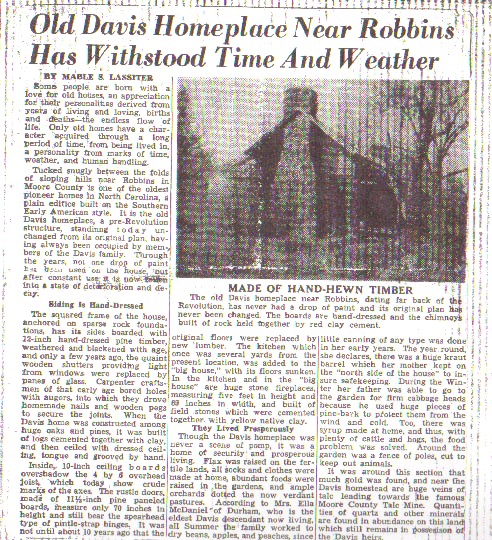
 |


(note: we are looking for a better copy of this article. If you can help please email ed@sandersweb.net)
By Mable S. Lassiter
Some people are born with a love for old houses, an appreciation for their personalities derived from years of living and loving, births and deaths — the endless flow of life. Only old houses have a character acquired through a long period of time, from being lived in, a personality from marks of time, weather, and human handling.
Tucked snugly between the folds of sloping hills near Robbins in Moore County is one of the oldest pioneer homes in North Carolina, a plain edifice built on the Southern Early American style. It is the old Davis homeplace, a pre-Revolution structure, standing today unchanged from its original plan, having always been occupied by members of the Davis family. Through the years, not one drop of paint has been used on the house, but after constant use it is now fallen into a state of deterioration and decay.
The square frame of the house, anchored on sparse rock foundations, has its sides boarded with 12-inch hand-dressed pine timber, weathered and blackened with age, and only a few years ago, the quaint wooden shutters providing light from windows were replaced by panes of glass. Carpenter craftsman of that early age bored holes with augers, into which they drove homemade nails and wooden pegs to secure the joints. When the Davis home was constructed among huge oaks and pines, it was built of logs cemented together with clay, and then ceiled with dressed ceiling, tongue and grooved by hand.
Inside, 10-inch ceiling boards overshadow the 4 by 6 overhead joist, which today show crude marks of the axes. The rustic doors, made of 11 1/2-inch pine paneled boards, measure only 70 inches in height and still bear the spearhead type of pintle-strap hinges. It was not until about 10 years ago that the original floors were replaced by new lumber. The kitchen which once was several yards from the present location, was added to the "big house," with its floors sunken. In the kitchen and in the "big house" are huge stone fireplaces, measuring five feet in height and 60 inches in width, and built of field stones which are cemented together with yellow native clay.
Though the Davis homeplace was never a scene of pomp, it was a home of security and prosperous living. Flax was raised on the fertile lands, all socks and clothes were made at home, abundant foods were raised in the gardens, and ample orchards dotted the now verdant pastures. According to Mrs. Ella McDaniel of Durham, who is the eldest Davis descendent now living, all Summer the family worked to dry beans, apples, and peaches, since little canning of any type was done in her early years. The year round, she declares, there was a huge kraut barrel which her mother kept on the "north side of the house" to insure safekeeping. During the Winter her father was able to go to the garden for firm cabbage heads because he used huge pieces of pine-bark to protect them from the wind and cold. Too, there was syrup made at home, and thus, with plenty of cattle and hogs, the food problem was solved. Around the garden was a fence of poles, cut to keep out animals.
It was around this section that much gold was found, and near the Davis homestead are huge veins of talc leading towards the famous Moore County Talc Mine. Quantities of quartz and other minerals are found on this land which still remains in possession of the Davis heirs.
|
Copyright © 2004 SandersWeb.net Contact: webmaster@sandersweb.net |
|